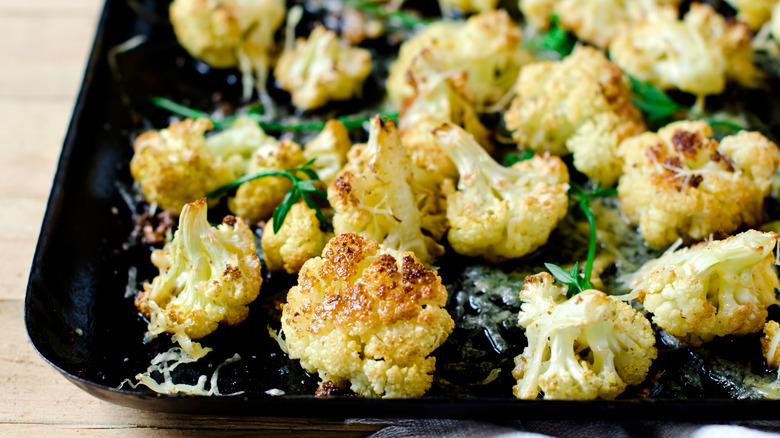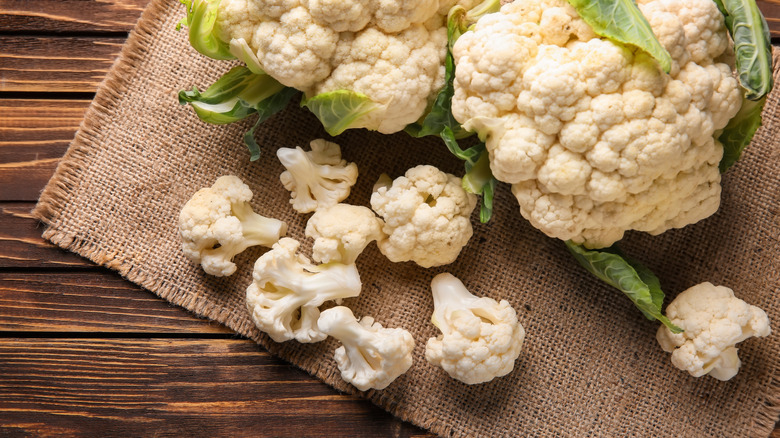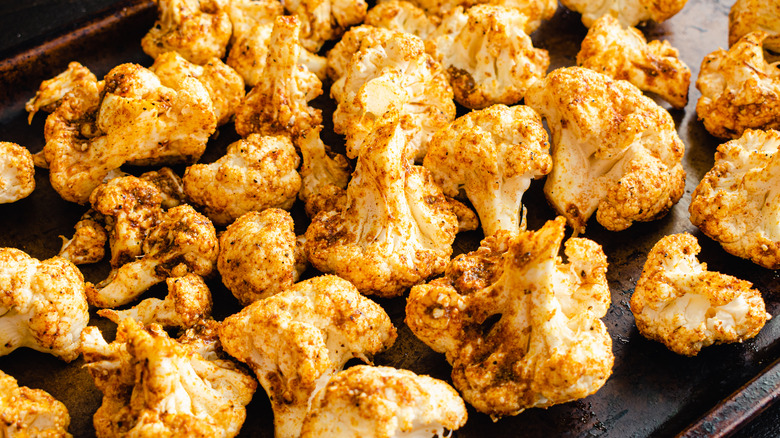What Is Melting Cauliflower And Why Is It Called That?
Cauliflower is one of the most versatile vegetables around. It takes well to different spices, flavors, and cooking methods. Go online, and you'll find dozens — if not hundreds — of different ways to prepare it. You can cut it into thick slabs and throw it on the grill, mash the cauliflower with roasted garlic, deep fry the florets and toss with hot sauce for a meat-free alternative to Buffalo wings, or, if you're counting your carbohydrates, grate into low-cal cauliflower rice. Even food manufacturers are getting into the cauliflower craze, transforming it into everything from pretzels to pasta to pizza crust.
But the best thing about this big, lovable cruciferous vegetable is that, even when you think you've stumbled across every way to prepare it, there's always more magic to discover. And that's why you have to try melted cauliflower. Don't let the name fool you, this method doesn't require a foundry, blow torch, or even hot wax. It's a pretty simple dual-cook technique that results in an intense flavor and luscious texture that quite literally melts in your mouth. "Melting" takes an already-roasted vegetable — in this case, cauliflower — and cooks it a second time in a thin layer of broth.
Why melting will be your new favorite cooking technique
Melting is a technique you'll want to add to your cooking repertoire. The first roast gives the cauliflower a mild toasty note and caramelization, while the second cook allows the florets to absorb the seasoned broth or stock, resulting in a finished product that's literally saturated in flavor. The "melted" element refers to the texture of the cauliflower. After a second roasting in a shallow pool of cooking liquid, the cauliflower breaks down further, becoming incredibly soft and delicate. It can then be served with the remaining liquid poured over it.
Before if you think melting is relegated to just cauliflower, think again. You can use the technique with any number of vegetables. Cabbage is a good option, especially if you're looking for something silky smooth and pleasantly soft. You can also melt vegetables that hold their form a little better; potatoes, onions, beets, and butternut squash are all well-suited for this technique. Melting can be used as an alternative to mashing or puréeing, providing a delightfully soft bite while still allowing the vegetable to retain its structure. Melted vegetables such as cauliflower are a natural match for hearty proteins and can be served alongside anything from herb-roasted chicken to lamb chops to grilled meat for a restaurant-worthy presentation.
Tips for melting vegetables
Melting is a straightforward cooking method, but there are a few things to consider before going forward with your initial attempt. First, make sure to use a rimmed, metal baking pan. This will help ensure that none of the liquid sloshes over the sides and onto the bottom of your oven. Second, properly prepare your vegetables. Whether it's a beet, potato, or head of cauliflower, thicker cuts tend to work better, allowing the ingredients to become tender while still holding their shape. The oven temperature should be hot, around 450 degrees Fahrenheit, to quickly give your vegetables some color and caramelization. Season everything with some olive oil or butter, salt, and pepper. If you're using cauliflower florets, roast them for 15 to 20 minutes; heartier vegetables will take a little longer.
Next, choose your liquid. Premade stock or broth is fine; choose a low-sodium variety if you want to control the salt content. You can also jazz up the cooking liquid with some dried herbs or seasonings. When going for that second roast, cook your vegetables until most, if not all, of the broth is absorbed. After the cauliflower is pulled from the oven, you can top it with some toasted nuts, crumbled cheese, or a herby green sauce for extra pop and texture. And there you have it: Now you're ready to melt a beautiful dish of cauliflower.


